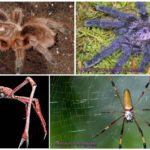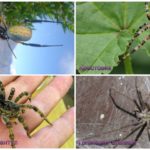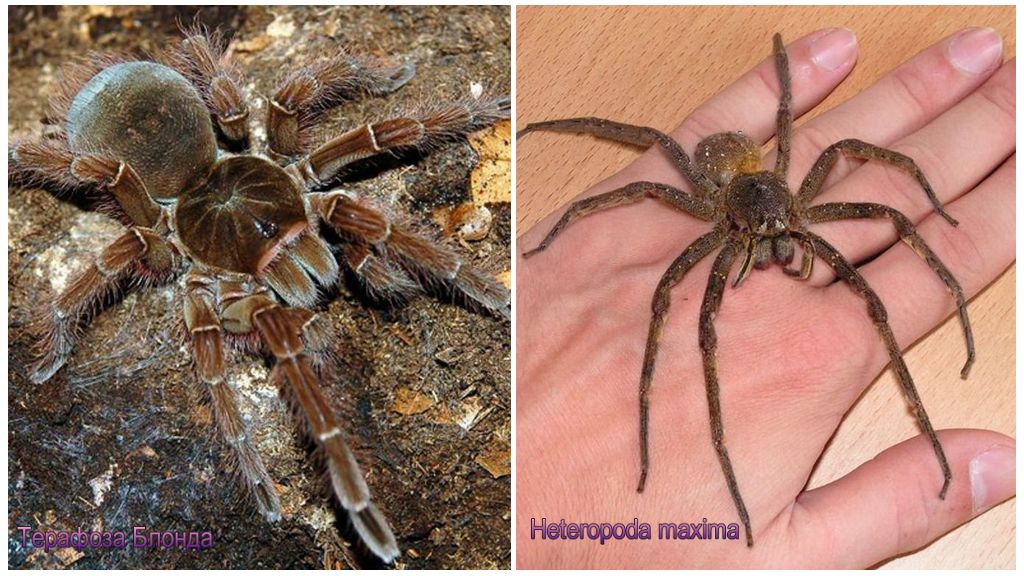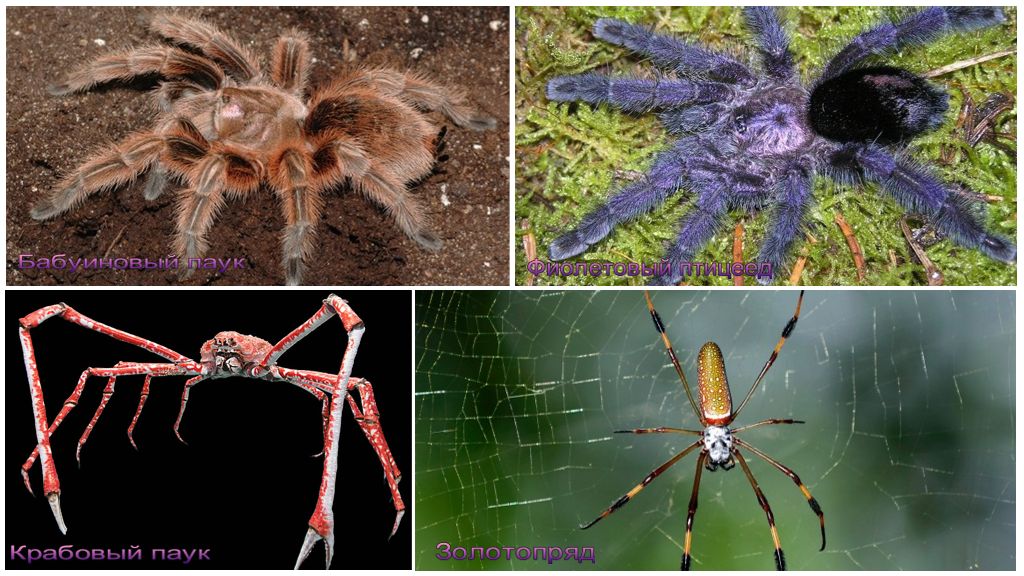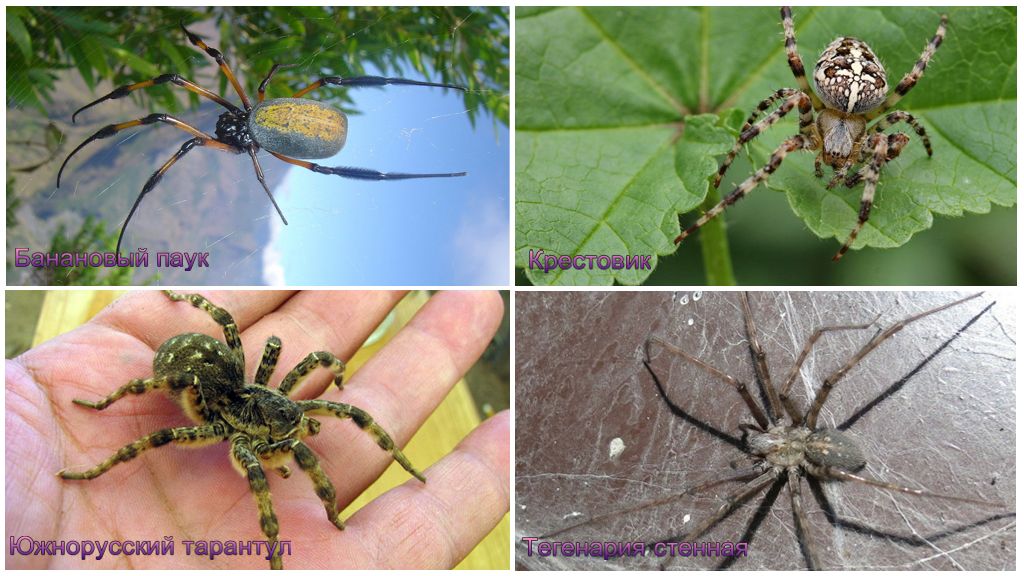Description and photos of the largest spiders in the world
Content
- The biggest spiders in the world
- The biggest spiders in the world
- The biggest spiders in the world
The largest spider in the world was discovered in the last century in Venezuela. The length of the body was 9 cm, the leg span reached 28 cm. The list of the largest representatives of arachnids included the inhabitants of tropical countries, but some of them live on the territory of Russia. When they bite, they all inject a toxic substance, but none of them can kill a person.
Top 10 giant spiders
In the world there are about 42 thousand species of spiders.When a bite is injected poisonous substance, paralyzing the victim, injected saliva, which dilutes the insides, sucks the contents. But not always the most huge spider is the most dangerous for humans.
Blond's terapha or Goliath bird
Arthropods with huge limbs, large abdomen, powerful jaws quietly hunt mice, frogs, snakes. The largest spider in the world was discovered in 1965 in Venezuela. The size of the legs was 28 cm, the body size was 9 cm. The average dimensions of the terafose were 8 cm, and the width of the limbs was 25 cm.
Dwells creature in Venezuela, Brazil, Suriname. The body is dark brown. Photos of the largest spider in the world are presented below. The animal has not gained wide distribution since it is prohibited to export from habitats; it practically does not reproduce in captivity.
Heteropoda maxima
The largest spider received such a rank due to its long limbs with a span of about 30 cm. The body length is 4.5 cm, which is inferior to the previous representative of arachnids. It lives in Laos. A large body of brown-yellow color, limbs with dark spots.One of the representatives is in the Paris Museum of the National Museum of Natural History.
Interesting!
Females, males of the same color, differ somewhat in size. They live in caves, eat insects. For humans, they are not dangerous. Frequently, exotic lovers often give birth as a pet. Due to the excessive interest of collectors, a huge spider is gradually disappearing from nature.
Baby spider
It lives in tropical, subtropical countries. The shaggy large creature with long brown hair grows to impressive dimensions. The leg span reaches 30.5 cm. It is one of the most friendly creatures on earth. The family lives together half a year, willingly shares food. Often relatives live in the neighborhood, dig joint tunnels. They hunt insects, small spiders, beetles. The poison is toxic, but not dangerous to humans. Often exotic collectors keep animals in terrariums.
Purple tarantula
The shaggy big spider lives in tropical countries, some species are found in Europe. Leg swing is 25 cm. They are nocturnal. Do not weave a web, waiting for the victim in secluded places.They know how to dig deep, long tunnels under the ground. During the run they develop impressive speed.
Large tarantulas have a unique color with a purple tint, thick, long hair covering the whole body, legs, powerful jaws. Often kept as a pet. The main diet consists of insects, small spiders, beetles, as well as amphibians, birds.
Interesting!
A well-fed female does not leave the shelter for months. A bite for a person does not represent a mortal danger, causes discomfort, pain.
Huntsman or Crab Spider
In nature, giant spiders live in Australia. Have a bright red-orange color. The span of the limbs reaches 31 cm. At the ends of the legs there are discrepancies resembling the claws of a crab, hence the name. The scary crab spider is not dangerous to humans, it preys on insects. In the process of chasing the victim develops great speed, it can jump well.
Gold mine
The rarest big spider. It lives on the island of Madagascar, South Africa. Known for its ability to weave a huge web. The diameter often reaches 1.5 m. The web is used by locals to make shiny, golden napkins, shawls, and fishing balls.The span of the gold-girdle's feet is 12 cm, body size is 4 cm.
A rare species of large spiders was officially introduced to humanity in 2000. Males are 2 times smaller than females, die immediately after mating. The poison is toxic, but not dangerous for humans. On the ground bite appears redness, swelling, allergy sufferers have difficulty breathing.
Interesting!
The American Museum has a large canvas measuring 3 square meters. m from the web of gold. It took 4 years to make it, dozens of workers, the spiders themselves. The threads were taken, the animals were released.
Banana spider
The largest in the history of spider, weaving a web. Its nets are so strong that birds get tangled in them, and fishermen use them to catch fish. The size of the body does not exceed 4 cm, the span of the legs reaches 12 cm. The color is bright - yellow with black stripes. Spiders live in Australia on banana trees. Many larvae are laid, thereby causing irreparable harm to the culture.
Interesting!
In 2010, the banana spider was recognized as the most poisonous on earth. The poison is extremely toxic, but with timely medical assistance death can be avoided.
South Russian tarantula
The giant spider belongs to the wolf family. It hunts insects, beetles, caterpillars. Homeland is Asia, live everywhere, are found on the territory of Russia, Ukraine. The body is gray-black in color, covered with thick hairs. Size about 3.5 cm. Lives in mink under the ground, hollows of trees. Rarely shows out, attacks from its secluded place. Web weaves at the entrance to the hole, as well as for the formation of a cocoon for the larvae.
People tarantula bites at risk for their own lives. At the site of the attack appears swelling, pain, redness. In children, people with weakened immunity, there is a weakness, headache, nausea, dizziness.
Krestovik
What this giant looks like is well known to the inhabitants of our locality. In the world there are about 1 thousand varieties of krestovik, about 30 lives in the countries of the former CIS. A distinctive feature in appearance is the presence of a light cross on the belly in the upper part. The size of a large spider reaches 2.5 cm.
Lives in the wild, shady places. Occurs in the forest, on the edge, as well as in abandoned houses, sheds, garden trees.The poison of a large spider is not dangerous to human life, but causes some discomfort, deterioration of health. At the site of the bite appears swelling, redness, then suppuration, pain. In children, people with weakened immunity, weakness, headache, chills, and other symptoms of intoxication appear.
Tegenaria wall
A large brown spider with long legs. Leg span is 15 cm. Lives in caves, on the walls of old houses, abandoned buildings. Dwells in Europe, Africa, Argentina, Asia. House spiders of this species live everywhere. The peace-loving creature bites a person in danger to their own lives. In most cases, trying to hide faster. A rather impressive speed is developed when running for a short distance.


